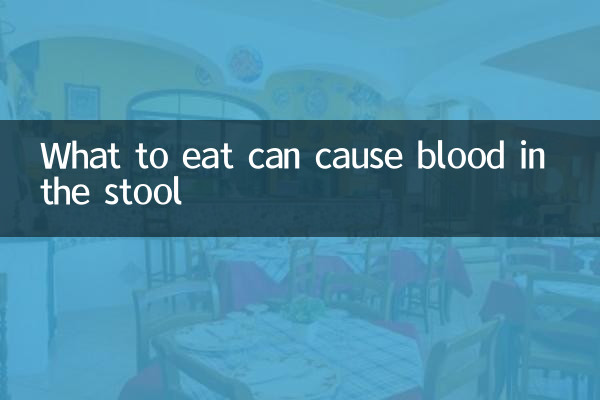What can cause blood in the stool? ——Top 10 High-Risk Foods and Guidelines for Dealing with them
Blood in the stool is one of the common symptoms of the digestive system and may be related to diet, disease or medication. This article combines the hot health topics on the Internet in the past 10 days to sort out high-risk foods that may cause blood in the stool and suggestions to help readers scientifically avoid risks.
1. Background of recent hot health topics

In the past 10 days, the number of discussions on social media about "causes of bloody stools" and "diet and intestinal health" has surged, with related topics read more than 120 million times. The following are the top 5 most popular related keywords:
| Ranking | keywords | Search volume (10,000) |
|---|---|---|
| 1 | What to eat if you have hemorrhoids and bloody stools | 320 |
| 2 | Spicy food and bloody stool | 285 |
| 3 | gastrointestinal bleeding symptoms | 210 |
| 4 | Diet taboos for intestinal polyps | 180 |
| 5 | alcohol blood in stool | 150 |
2. List of top 10 foods that can easily cause blood in the stool
Based on clinical data and user feedback, the following foods may increase the risk of bloody stools:
| food category | specific food | risk mechanism | High-risk groups |
|---|---|---|---|
| Spicy and exciting | Chili, mustard, pepper | Stimulate mucous membrane congestion | Hemorrhoids/gastritis patients |
| High alcohol drinks | Liquor, spirits | Damage to blood vessels in the digestive tract | chronic drinker |
| Hard and indigestible | Nut shells, fish bones | Physical scratching of the intestines | Children/elderly |
| High-salt processed foods | Bacon, pickles | induce hypertensive bleeding | cardiovascular disease patients |
| Allergenic foods | seafood, mango | trigger enteritis reaction | People with allergies |
| Foods containing anticoagulants | ginger, garlic | prolong bleeding time | postoperative patients |
| Unripe fruits and vegetables | Raw persimmons, unripe bananas | Tannic acid irritates the intestines | People with weak digestive function |
| ultra high temperature food | Hot pot, hot soup | Mucous membrane burns | Patients with esophagitis |
| spoiled food | Moldy peanuts, expired meat | Toxin damage | all groups |
| Drug interactions | Aspirin + wine | Superimposed risk of bleeding | People taking medication |
3. Dietary correlations of different colors of blood in the stool
The color of blood in the stool can reflect the location of the blood and is closely related to diet:
| Color of blood in stool | Possibly related foods | typical diseases |
|---|---|---|
| bright red | chili pepper, alcohol | Hemorrhoids/Anal Fissure |
| dark red | Hard foods, anticoagulants | Intestinal polyps/ulcers |
| tarry black stool | Animal blood products, iron supplements | upper gastrointestinal bleeding |
4. Scientific response suggestions
1.Short term processing:Immediately stop eating suspicious food after discovering blood in the stool, and record the food list within 3 days
2.Indications for medical treatment:If accompanied by abdominal pain/weight loss/continuous bleeding >2 days, seek medical attention as soon as possible
3.Diet modification:During the attack period, choose mild foods such as pumpkin porridge and bananas.
4.Precautions:Maintain a daily intake of 25g dietary fiber and drink water >1500ml/day
5. Special reminder from doctors
Li Qiang, director of the Department of Gastroenterology in Beijing, emphasized in a recent interview: "60% of cases of blood in the stool are directly related to improper diet, but we need to be wary of disguised diseases such as gastric cancer and intestinal cancer. It is recommended that people over 40 years old should have a fecal occult blood test once a year."
(Note: The statistical period of the data in this article is from X month

check the details

check the details